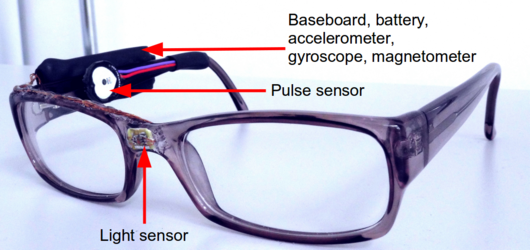 I just ordered a fitness tracker from Amazon the other day. It’s the first time I’ve tried one, and I’m getting it mostly for its sleep-tracking feature, but the fact that it counts steps and calories burned will undoubtedly be useful, too (or maddening, we’ll see). I’ve always been very curious about devices that measure how many calories you’re burning, but I’ve also wished that they had the capability to detect how many calories you’re taking in. I’m too lazy for traditional calorie-counting; plus, it’s tricky to determine how many calories you’re getting from a scoop of homemade casserole, for instance.
I just ordered a fitness tracker from Amazon the other day. It’s the first time I’ve tried one, and I’m getting it mostly for its sleep-tracking feature, but the fact that it counts steps and calories burned will undoubtedly be useful, too (or maddening, we’ll see). I’ve always been very curious about devices that measure how many calories you’re burning, but I’ve also wished that they had the capability to detect how many calories you’re taking in. I’m too lazy for traditional calorie-counting; plus, it’s tricky to determine how many calories you’re getting from a scoop of homemade casserole, for instance.
Considering the amazing things that technology can already do, and how quickly it’s advancing, I’ve assumed that eventually someone will come up with some kind of a device that can detect the number of calories a person ingests. As it turns out, someone has. Professor Oliver Amft from the University of Passau has developed a pair of smart eyeglasses that utilize electromyography to determine just what it is you’re eating, and how much of it.
Electromyography (EMG) is a technique that measures the electrical activity generated by muscles. It’s commonly used as a diagnostic tool to assess the health of muscles and nerves, but in this case, it’s being used to detect how hard the muscles in your jaw are working when you’re chewing. Dr. Amft developed a series of tiny sensors and embedded them in a 3D printed glasses frame – more specifically, in the arms of the frame, which touch the sides of the wearer’s face. The sensors pick up the electrical activity generated by the muscles of the jaw while the wearer is chewing, and thus can detect how hard those muscles are working – telling the sensors what type of food you’re masticating.
It’s not a perfect science – while the sensors can tell the difference between, say, a banana and celery, they’re less able to distinguish between foods of similar consistencies. The device is still just a prototype, though, part of a larger project called WISEglass. Dr. Amft and his fellow researchers are working to develop regular eyeglasses with embedded sensor technology that can detect different activities the wearer is performing, such as reading or walking. A light sensor can also detect the blue light emitted from screens, which can interfere with the sleep cycle; if the wearer is getting too much screen time late in the evening, the sensor sends a notice to their smartphone telling them they should power down if they want to ensure a restful night’s sleep.
 Eventually, the researchers hope to hide all of this technology inside ordinary eyeglasses. WISEglass has also been tested as a wearable video game controller, so you can play your favorite game simply by moving your head from side to side, while the glasses tell you how that movement affects your heart rate – as well as, likely, how many calories you’re burning (and also ingesting from the bag of potato chips sitting next to you).
Eventually, the researchers hope to hide all of this technology inside ordinary eyeglasses. WISEglass has also been tested as a wearable video game controller, so you can play your favorite game simply by moving your head from side to side, while the glasses tell you how that movement affects your heart rate – as well as, likely, how many calories you’re burning (and also ingesting from the bag of potato chips sitting next to you).
The University of Passau’s research was presented earlier this month at the International Conference on Wearable and Implantable Body Sensor Networks, and will soon be published in a paper entitled “Diet eyeglasses: Recognising food chewing using EMG and smart eyeglasses.” Hmmmm…quite an idea! Would you be interested in a pair of these? Tell us over in the 3D Printed Smart Eyeglasses forum at 3DPB.com.
Subscribe to Our Email Newsletter
Stay up-to-date on all the latest news from the 3D printing industry and receive information and offers from third party vendors.
Print Services
Upload your 3D Models and get them printed quickly and efficiently.
You May Also Like
Printing Money Episode 30: Q1 2025 Public 3D Printing Earnings Review with Troy Jensen, Cantor Fitzgerald
Printing Money is back with Episode 30, and it’s that quarterly time, so we are happy and thankful to welcome back Troy Jensen (Managing Director, Cantor Fitzgerald) to review the...
3DPOD 260: John Hart on VulcanForms, MIT, Desktop Metal and More
John Hart is a Professor at MIT; he´s also the director of the Laboratory for Manufacturing and Productivity as well as the director of the Center for Advanced Production Technologies....
Etsy Design Rule Change Reduces Selection of 3D Printed Goods
Online marketplace Etsy has implemented a rule change requiring all 3D printed goods on the site to be original designs. The update to the site’s Creativity Standards states, ¨Items produced using...
3DPOD 259: AM at Stratasys with Rich Garrity, Chief Business Unit Officer
Rich Garrity is the Chief Business Officer of Stratasys. Rich shares Stratasys´ vision and future with us. We talk about machines, applications, clients, and the market in general. What technologies...



































